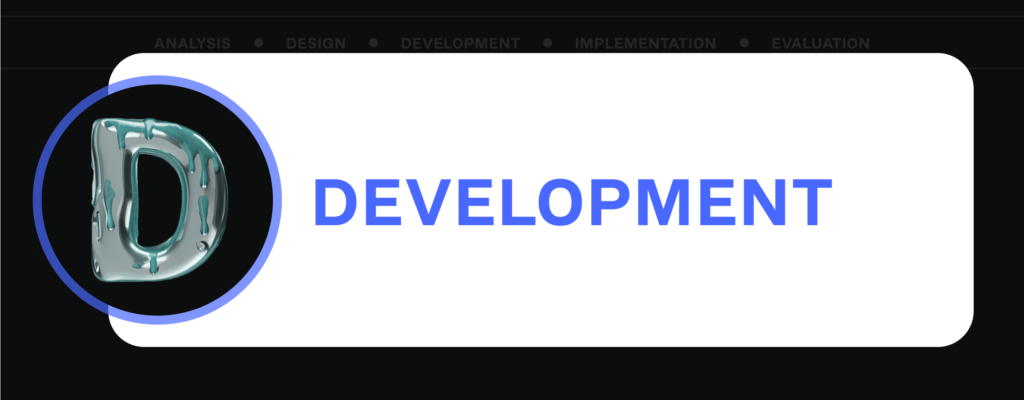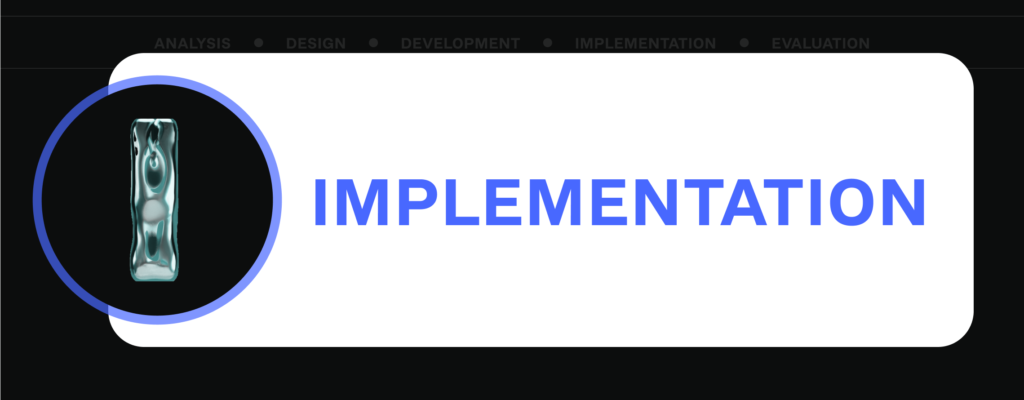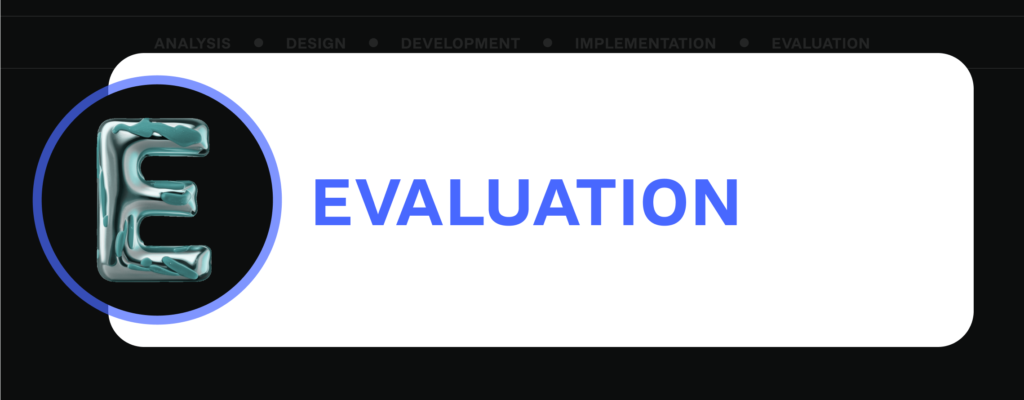The ADDIE model is one of the fundamentals of instructional design that represents a systematic and organized way to design an effective learning experience. The five-phase process includes Analysis, Design, Development, Implementation, and Evaluation.
Introduction to ADDIE Model of Instructional Design
Instructional design models like ADDIE are crucial for several reasons. They provide a roadmap for creating engaging and impactful learning experiences by:
- Ensuring learner-centeredness
- Promoting efficiency and effectiveness
- Improving quality and consistency
- Facilitating collaboration
In this article, we will further dive into the ADDIE model instructional design includes, providing a description of each phase. We will cover the high-level activities, factors and tools involved in each stage, exploring the pros and cons and their applicability in various learning contexts.
I. Analysis
This crucial initial phase of the ADDIE model for instructional design involves a thorough examination to pinpoint specific training needs. Here’s a breakdown of key areas:
- Performance Gaps arise when an individual or team’s actual performance falls short of desired expectations. It is identified by first defining desired performance through job descriptions, performance standards, and industry benchmarks. Then, actual performance is assessed through methods like performance reviews, observations, surveys, and data analysis. By comparing desired performance with actual performance, organizations can pinpoint critical performance gaps through needs assessments and prioritize areas for improvement.
- Learner Analysis involves a detailed analysis of the target audience, performed to avoid ineffectual training. This will include assessing their current knowledge and gaps, assessing technical or non-technical skills, their “interest-to-learn” attitude, motivation-assessment, and insight on demographic background, such as age, education, and culture. It is essential to know if an individual who is learning has a different approach to training so that he can make the best out of the entire learning experience available.
- Task Analysis is a structured approach to decompose complicated tasks into smaller, achievable pieces. This includes outlining the skills and knowledge needed for every task, the order of tasks that need to be undertaken, and the most important tasks that affect job performance. The analysis serves as a foundation for job design, training programs, performance assessment, and job effectiveness in general.
- Organizational Analysis involves a comprehensive evaluation of various factors within an organization to determine the feasibility and effectiveness of training programs. This covers the evaluation of availability as well as the sufficiency of budget, time, technology, and training setup. Also, Organizational Analysis must find and limit the effect of possible constraints such as budget constraints, time constraints, access to technology, and resistance to change. This acceptance becomes vital in how receptive the organizational culture is to the learning and development component. Last but not least, it also requires a significant amount of management support to effectively implement training initiatives, as it provides basic resources as well as valuable guidance and encouragement.
Through detailed analysis of performance gaps, learner characteristics, required tasks, and the organizational context, training professionals can formulate effective training by targeting specific needs to produce desired performance outcomes.

II. Design
This is the core phase of the ADDIE model in Education where the instructional plan is developed. Here’s a deeper dive into the key components:
- Learning Objectives
The ABCD model is a framework for writing clear and effective learning objectives. It stands for:
Audience: Who are the learners?
Behavior: What should the learners be able to do?
Condition: Under what circumstances will the learners perform the behavior?
Degree: How well must the learners perform the behavior?
By following this model, you can ensure that your learning objectives are specific, measurable, achievable, relevant, and time-bound (SMART).
- Instructional Strategies
Teaching Methods:
- Lectures: Effective for conveying information, but can be passive.
- Discussions: Promote critical thinking and active learning.
- Simulations: Provide students with hands-on experience and practice in a safe setting.
- Case Studies: Apply theoretical concepts to real-world scenarios.
- Role-playing: Learn social and communication skills
- Demonstrations: Show learners how to perform a task.
- Group work: Foster collaboration and teamwork.
Learning Activities:
- Exercises: Practice specific skills and concepts.
- Assignments: Apply learning to real-world situations.
- Projects: Allow learners to demonstrate their understanding and skills through a larger, more in-depth task.
- Readings: Provide supplementary information.
- Assessment Methods
- Tests: Measure knowledge and comprehension (e.g., multiple-choice, essay).
- Quizzes: Short assessments to check and understand specific topics.
- Observations: Assess performance and skills in a real-world setting.
- Portfolios: Showcase a collection of learner work demonstrating growth and achievement.
- Projects: Evaluate the application of knowledge and skills to a complex task.
- Self-assessments: Encourage learners to reflect on their own learning.
- Instructional Materials
- Videos: Offer dynamic and engaging learning experiences, such as interactive quizzes, animated lectures, and AI-driven real-world examples.
Useful Platforms for Instructional Design
Panopto is an on-demand platform for lecture capture and video management with features such as screen recording, captioning, and video editing.
Elai.io is an AI-driven video platform specifically designed for creating interactive video training, allowing to embed quizzes, polls, and AI avatars directly into their videos.
- Handouts: Provide key information and support learning activities.
- Presentations: Engage learners visually and convey information effectively.
- Workbooks: Provide structured exercises and activities.
- Online resources: Access to supplementary materials, interactive exercises, and online discussions.

III. Development
This is the crucial stage where the instructional design plan is transformed into concrete learning experiences.
- Creating successful educational materials is a multi-step process. First of all, a variety of materials are developed in keeping with a comprehensive understanding of learning objectives, learner characteristics, and anticipated assessment techniques, including not only textbooks but also workbooks, presentations, videos, and interactive exercises. Next, stringent quality checks are held to make sure the materials are accurate, clear, relevant, and accessible to any learner, including those with disabilities. Last of all, pilot testing with a small group of learners helps to pinpoint and solve any problems before this method is fully applied. In this way, the materials created are both effective for their target audience and yet popular with them.
- Building effective learning environments requires careful consideration of both physical and online spaces. In physical classrooms, preparation involves ensuring a well-ventilated and adequately lit space with necessary tools and a layout that fosters interaction. Comfort is crucial, encompassing factors like temperature, noise levels, and visual distractions. Online platforms necessitate careful selection based on course needs and learner requirements. Customization is key, involving the integration of course content, activities, assessments, and communication tools while maintaining user-friendliness. Accessibility for learners with disabilities must be prioritized through features like screen reader compatibility and alternative text for images
Key Considerations:
- Learner Engagement
- Diversity
- Motivation
- Technology Integration
By carefully developing high-quality learning materials and creating supportive learning environments, the Development phase plays a critical role in the success of any instructional design initiative.

IV. Implementation
This phase focuses on delivering the instruction as designed and ensuring a smooth and effective learning experience for participants.
Key Activities:
- Delivering Instruction:
- Effective Training Sessions
- Facilitating Learning
- Monitoring Progress
- Logistics and Coordination:
- Training Logistics
- Stakeholder Coordination
The Importance of Proper and Effective Implementation:
Increased Learner Engagement and Satisfaction: A properly designed and conducted training program usually results in better learner engagement, satisfaction, and motivation.
Knowledge Retention Boost: The appropriate delivery methods and activities boost knowledge retention and speed up skill transfer.
Training Objectives: The efficient training materials help in the effective execution of the learning objectives and achieving the desired training outcomes.
Maximum ROI: The proper implementation makes sure that the return on investment made in the training program is maximum and well executed, proving that the course is cost-effective.
The fourth phase of the ADDEI Modei – Implementation phase- is an essential part that ensures that the training is well-structured and aligned with its intended learning outcomes and business goals.

V. Evaluation
The Evaluation step is the final and highly important part of the ADDIE training model, evaluating your training program. It’s a journey, not a destination.
- Formative evaluation takes feedback on what works and what does not work during the training process to make the required tweaks. That includes methods such as learning the feedback forms, and directly observing training events and institutional focus groups. These methods assist in assessing the clarity of instruction, instructor effectiveness, relevance of content, and trainee engagement. The data has been used to alter training content, teaching methods, training material, and the entire training schedule, making sure that the program does not lose relevance with it even if the new program is a success.
- Summative Evaluation measures the effectiveness of a training program as a whole, after completion. These include knowledge tests (to determine content retention), skills demonstrations (to assess practical application), and performance observations (to measure actual performance). Various surveys solicit feedback from managers regarding the effects of training on the productivity of employees. ROI analysis measures return on investment, which can be quantified in productivity gains, lower costs, and better quality. It also includes organizational outcomes like improved employee morale and improved competitiveness. Including how evaluation data are gathered and reported helps assess whether the program is achieving its intended impact.
Key Considerations:
- Data Collection
- Data Analysis
- Action Planning
- Continuous Improvement
With the right mix of formative and summative evaluation, organizations can ensure that their training programs are aligned with their goals and provide a strong return on investment.

Conclusion
The ADDIE model is considered to be one of the foundations of instructional design and it is a systematic and structured approach to design effective learning experiences. Following the sequence of Analysis, Design, Development, Implementation, and Evaluation, its framework ensures a systematic, and learner-focused training program. This model helps organizations create high-quality training programs that deliver targeted learning, improve employee performance, and meet the desired business results.
FAQ
What is ADDIE model?
The ADDIE model is a five-phase instructional design framework:
Analysis: Identify training needs, analyze learners, and assess the organizational context.
Design: Develop learning objectives, choose instructional strategies, and create assessment methods.
Development: Create learning materials, build learning environments, and conduct pilot testing.
Implementation: Deliver instruction, facilitate learning, and monitor progress.
Evaluation: Conduct formative and summative evaluations to assess program effectiveness.
What is the application of ADDIE model in teaching and learning?
The ADDIE model is a framework for the design and development of effective teaching and learning experiences. It lays down a set of agreed-upon principles that should inform the whole process of instructional design, thus avoiding random planning, encouraging the understanding of target audiences and hence, guided instruction design, and, certainly aids in the development of effective learning resources and stimulating activities. The ADDIE Model is flexible and serves as a step-by-step guide to making efficient use of instructional resources, and, last but not least, its implementation provides opportunities for continuous assessment and improvement of the quality of teaching and learning.

